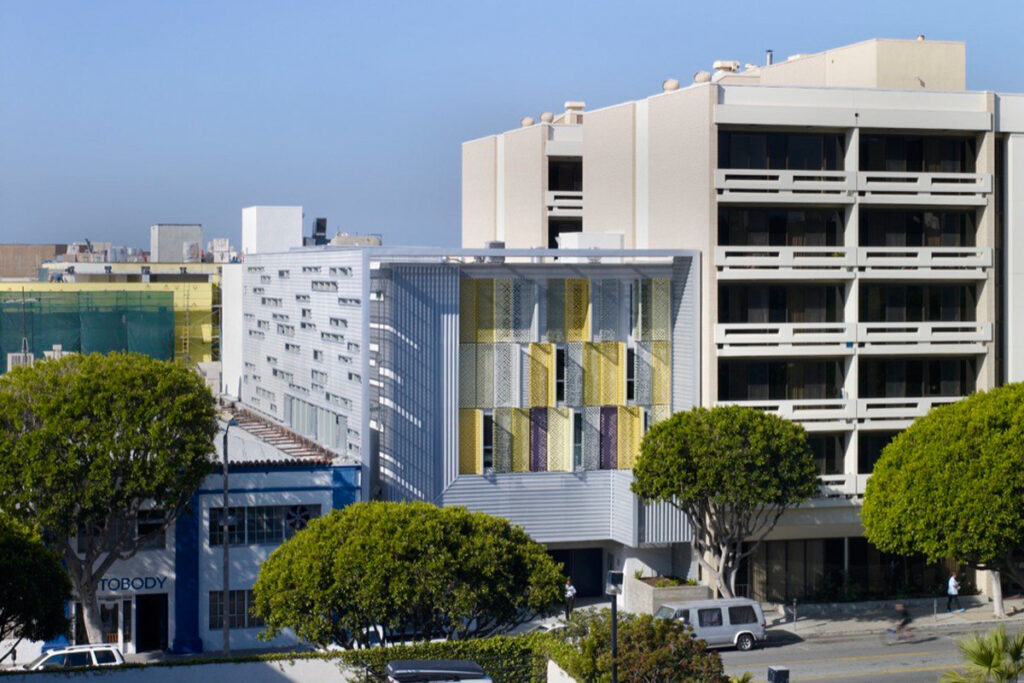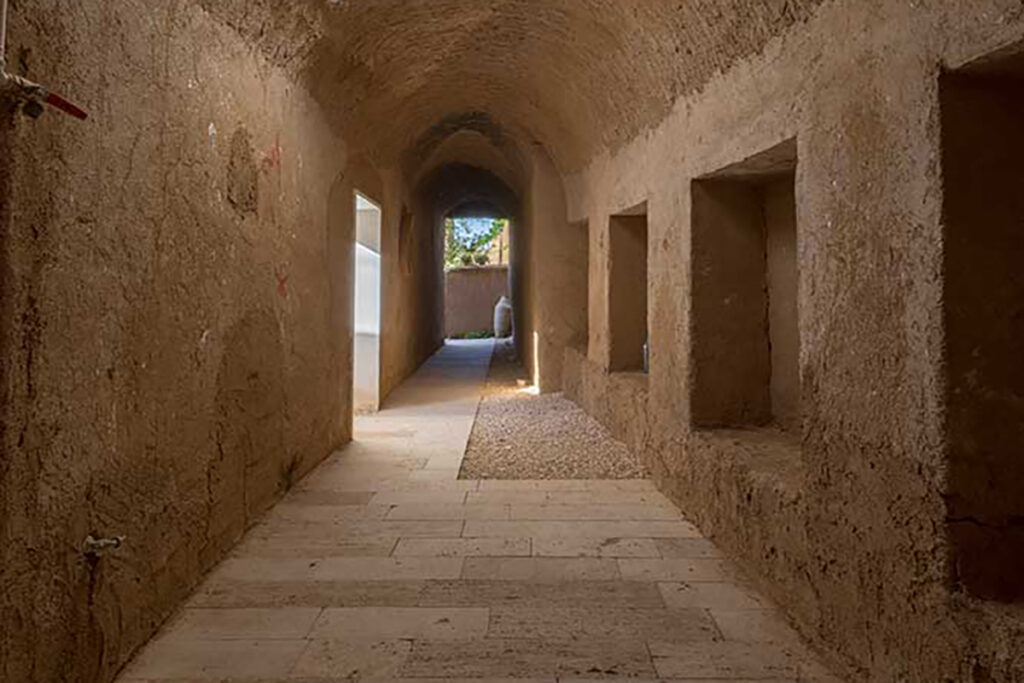ویلای مایان، اثر افشین خسرویان


ویلای مایان
ویلای مایان در کنارهی بیرونی سومین روستای توریستی ییلاقی مشهد با قدمت 1800 سال قرار دارد. زمینی با عرصهی 265 مترمربع به عرض 9 متر در زمینی صخرهای با شیب تند که ویژگی خاص آن چشم انداز بکر و پیوندش با زمینه است. رابطهی همساز بین حجم و زمینه به گونهای که کمترین تغییر در ریخت (شکل) تاریخی-طبیعی زمینه صورت پذیرد، مهمترین محور اندیشهی طرح برای تیم طراحی بود. در این راستا، مطالعه و شناسایی کامل الگوهای بومی از ریختشناسی بافت روستای تاریخی تا اکولوژی محیط طبیعی کمک شایانی به شکلگیری طرح نمود.
با توجه به محدودیت سطح عرصه، توپوگرافی شدید و آب و هوای ییلاقی منطقه، طراحی در برش به عنوان فرایندی برای شکلگیری نحوهی رابطهی زمینه و حجم و حل مسایل آن مورد استفاده قرار گرفت. قرار دادن تنها دو حجم ( حجم ورودی-پارکینگ و حجم اقامتی) در دو سطح و برقراری رابطه بین آنها به وسیلهی فضای سبز و روف گاردن پاسخ مناسبی به برنامه و منظر و عرصهی باز پروژه داد.
ایوانها نقش کلیدی در کاهش جرم حجم برای تقویت رابطه با زمینه از طریق تامین دید و نور مناسب را بازی میکنند. امتداد حیاط سبز، ایوان نسبتا عمیقی را شکل میدهد که فضای نشیمن مسقف و همچنین محرمیت نسبی جانبی را جهت استخر تعریف مینماید. همچنین ،حیاط طبقهی اول که جهت تامین محرمیتی مناسب از ساختاری باز و بسته شونده از پوشش گیاه بومی منطقه به نام ارغوان، جزو صنایعدستی منطقهی طرقبه در مشهد، استفاده شده است. شایان ذکر است که سایهی ناشی از فضای نشمین مسقف و آب استخر که در مسیر نسیم منطقه، از سوی دره، قرار دارد ایجاد پدیدهی دودکشی میکند که با باز نمودن پنجرهی طبقهی بام تاثیر بسیاری در کاهش مصرف انرژی در ایام ییلاق را داراست به گونهای که مصرف انرژی در طبقهی همکف به نزدیک صفر میرسد.
بر اساس الگوی ساخت و متریال طبیعی–تاریخی زمینه، اندود پروژه از کاهگل طبیعی منطقه همراه با اندکی خاک آهن دار و آجر صورت گرفته و طبقهی همسانی با زمینه و القای حس منطقه، بو، صمیمیت خاصش را با جزئیات سادهی چوبی و بومی به نما اضافه مینماید.جزئیات دیوارکوبها و تزئینات نورپردازی همه با جزئیات بومی و هنرهای دستی منطقه اجرا گردیده است.
کتاب سال معماری معاصر ایران، 1400
____________________________
عملکرد: مسکونی
_______________________________________
نام پروژه : ویلای مایان
عملکرد : مسکونی
شرکت، مهندسین مشاور / دفتر طراحی: شرکت مهندسین مشاور فراطرح شرق
معماران اصلی : افشین خسرویان
همکاران طراحی : علی جاوید، فهیمه کریمی
طراحی و معماری داخلی : مهسا صداقت
کامپیوتر و گرافیک : علی جاوید، فاطمه کریمی،سمیه اسعد
نظارت:وجیهه ابریشمی
سازه : هومن موحد اول
تاسیسات مکانیکی : مهدی پزشکی راد
کارفرما : خانواده معمار
نوع سازه : سازه فلزی – تیرچه کرومیت
نوع تاسیسات : سرمایش (کولر آبی)، گرمایش (سیستم گرمایش از کف)
آدرس پروژه: روستای مایان مشهد
مساحت زمین : 265 متر مربع
زیربنا : 242 متر مربع
تاریخ شروع و پایان ساخت : 1398-1397
عکاس پروژه: استودیو نیمکت
وبسایت: www.afshin-khosravian.com
ایمیل: faratarh.arc@gmail.com
اینستاگرام: afshin.khosravian
Villa Mayan, Afshin Khosravian

Project Name: Villa Mayan, Iran Building of the Year, 2021, Honorable Mention / Function: Residential / Design Office: Afshin Khosravian & Associates / Architect: Afshin Khosravian / Design Colleagues: Ali Javid, Fahimeh Karimi / Interior Designer: Mahsa Sedaghat /Computer and Graphics: Ali Javid, Fatemeh Karimi, Somayeh Asadi / Supervision: Vajiheh Hosseini Abrishami / Structure: Hooman Movahed Avval / Mechanical Installation: Mehdi Pezeshkirad / Employer: Architect’s Family / Type of Structure: Steel Structure, Chromite Beams / Type of Installation: Cooling System (Water Cooler), Heating System (Underfloor Heating System) / Land Area: 265 square meters / Built-Up Area: 242 square meters / Date of Construction Commencement and Completion: 2018-2019 Project Address: Corner of 1st Golestan St., Mayan Sofla, Mayan Village, Mashhad, Khorasan Razavi, Iran / Project Photographer: Nimkat Studio
Website: www.afshin-khosravian.com
Email: faratarh.arc@gmail.com
Instagram: @afshin.khosravian
Villa Mayan is located on the outer side of the third summer tourist village of Mashhad with a history of 1800 years. A land with area of 265 square meters with a width of 9 meters in a rocky land with a steep slope, which is characterized by a pristine landscape and its connection with the ground. The most important axis of thought for the design team was the harmonious relationship between volume and context so that the least change in the historical-natural form of the background takes place. In this regard, the study and complete identification of native patterns from the morphology of the texture of the historic village to the ecology of the natural environment helped to form the design. In the theoretical field of the project, we intended to find a new model to prevent the penetration of urban architectural patterns (especially of the undesirable type) to the villages. Trying to challenge the culture of excellence in architecture and provide an example of cheap and easy material that speaks of different qualities was one of our other intentions in design. Due to the limited area, severe topography and summer climate of the region, design in cutting was used as a process to form the relationship between context and volume and solve its problems. Placing only two volumes (entrance-parking volume and residential volume) on two levels and establishing a relationship between them through green space and roof garden gave a suitable response to the program, landscape and open area of the project. Porches play a key role in reducing the mass of the volume to strengthen the relationship with the ground by providing adequate visibility and light. The extension of the green courtyard forms a relatively deep porch that defines the covered living space as well as the relative lateral privacy of the pool. Also, the yard of the first floor, has been covered with the opening and closing structure of a native plant called Judas-tree (Arghavan) (handicrafts of Torqabeh region of Mashhad) to provide proper privacy. It is worth mentioning that the shadow caused by the roofed living space and the pool water, which is located in the direction of the region’s breeze (from the valley), creates a chimney phenomenon, which has a great effect on reducing energy consumption during summer by opening the roof floor window in such a manner that energy consumption in the summer on the ground floor reaches zero. Based on the pattern of construction and natural-historical materials of the background, the building is covered with natural cob with a little iron soil and brick and the floor is in harmony with the background and adds a sense of area, smell, special intimacy with simple wooden and native details. The details of the wall sconces and lighting decorations are all done with local details and handicrafts of the area. Our design plan includes attempting to use simple details and native materials or to optimize the use of new materials used in the village with special intimacy and refinement. For example, sanitary services are made of cheap and quality cement, which creates a pleasant smell.





















































